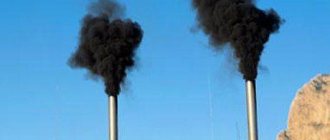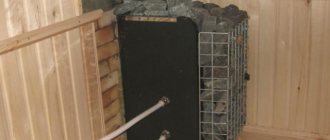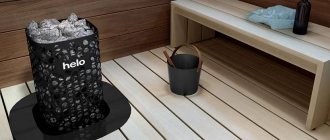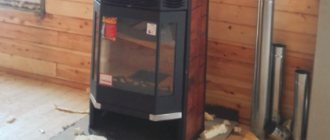One way or another, all owners of Russian wood-burning steam rooms have encountered a situation where the stove in the bathhouse smokes. What to do if a cloud of burning appears at the most inopportune moment, poisoning the air in the waiting room or steam room. The presence of back exhaust of incomplete combustion products from a normal, repeatedly tested stove indicates that somewhere inside the well-functioning combustion process a high-pressure zone has formed, due to which the sauna stove smokes and releases fumes into the steam room. Everything else is the invention of sellers and inept stove makers.
Backdraft - Temperature and Humidity
Why does the stove smoke into the house?
The natural extraction of flue gases through the chimney is based on the laws of physics. Of primary importance here are the temperatures indoors and outdoors, as well as the difference between them.
Poor traction is the scourge of warm weather in the off-season. For example, after a summer of inactivity, it takes special skill to light the stove in the fall so that smoke does not enter the house.
Also, the air can “stay” even in cold weather if the owners left the house and it froze. If the temperatures inside and outside are equal, there will be no draft.
Humidity can also play a role. For example, when slanting downpours occur and water enters the pipe, this upsets the temperature balance and the draft worsens.
In warm weather, or in a frozen house, paper is burned for kindling. It needs to be placed as far into the oven as possible; if this does not help, then into the far well through the cleaning door. Closer to the pipe, make a small fire made of paper or small wood chips. This is necessary in order to warm up the brick. Warm air will rise and draft will be established.
In hot weather, it is extremely difficult to establish traction.
Checking the condition of the firebox and ash pan
It is clear that if you take on the “dirty” job of cleaning the stove, it would be correct to simultaneously check for the presence of soot inside the combustion chamber. The settling and turning of the flow for a few seconds does not mean that the stove immediately begins to smoke, but it is at these moments, imperceptible to the eye, that dirt is thrown from the stove pipe into the firebox.
Therefore, for preventive purposes, the brick vault and passages, as in the diagram, need to be blown out and cleaned with a vacuum cleaner. As a rule, after cleaning there are always cracks, especially around the fire door fastening and in the area of the transition to the smoke channel. Such cracks can smoke before the chimney warms up, or, conversely, suck in air, reducing the already poor draft of the stove in the bathhouse.
If you suddenly find a plug made of crumbling brick in the smoke ducts, you will have to pick out the inspection plug made of brick halves with a spatula and remove dirt through the opened window.
Sauna stove repairs are carried out using special clay grouts. For the hot part, clay with fireclay powder and asbestos is used, the rest is rubbed with greasy clay with chopped asbestos fiber and sand.
Sometimes the stove begins to smoke due to a mismatch in the size of the firebox. The large space of the combustion chamber takes a long time to warm up and, most importantly, unevenly. As a result, part of the very hot flue gases is reflected from the roof, as in a Russian stove, and is squeezed out onto the firebox door.
Accordingly, the coating of the opening, the wire and the door frame burn, the combustion chamber begins to smoke, as if there was no draft in the pipe. The stove also smokes in a situation where the outlet to the chimney is located below the grate.
In both cases, the problem is solved by installing an additional fireclay wall inside the firebox.
A stove in a bathhouse may start to smoke if the outlet of stove gases into the chimney channel is combined with the channel from an additional dryer or wood-burning water heater. In this case, you cannot light two stove devices at the same time. The furnace with the largest volume of the combustion chamber needs to be heated first.
Wind
A temporary cause of backdraft can be the wind, the direction and strength of which “drives” the smoke back into the chimney. Tall trees or buildings located near the house can contribute to this.
Install an umbrella or deflector on the top edge of the pipe. These devices significantly improve draft, protect from rain and prevent the wind from blowing smoke back into the chimney.
To date, many deflector designs have been developed. There are rotating models that are themselves installed by the force of the wind so that there is no interference with the smoke.
Many people are interested in the question: how to line an iron stove with bricks? Read useful information in our article. For information on self-repair of Ariston water heaters, see here.
Read about winter kits for air conditioners at this link.
Incorrect laying of a stove or well
An important condition for good smoke removal is sufficient chimney clearance. The pipe must be at least 15 cm in diameter (for a sauna stove - 10 cm).
During laying, the stove maker rubs the inner surface of all wells and pipes with a damp rag. If possible, all sharp internal corners are trimmed and turns are smoothed out. This creates a smooth inner surface along which smoke can easily move upward. This is done as the furnace is being laid. But you cannot plaster the inside of chimneys.
Any turn or additional well is another obstacle in the path of smoke. Therefore, the length of the pipe and its location on the roof must be adequately designed for the design of a particular stove.
It is also important that the entrance to the first well (inside the firebox) is not lower than the top edge of the door. Otherwise, there is a possibility that every time the fuel chamber is opened, smoke will flow into the room.
The stove maker's mistakes come at a cost. Something in the design can be corrected only by moving part of the stove, or maybe by completely rebuilding it.
A tall, straight pipe with a smooth inner surface can be a salvation if minor miscalculations are made and the draft is weak:
- If located close to the ridge, the pipe should be at least 50 cm higher than it.
- When located 1.5 - 3 m from the ridge, the height of the pipe is allowed to be level with the ridge or higher.
- The pipe can only be slightly lower than the ridge if it is located more than 3 m from it.
- A chimney height of 5 m or more is capable of providing full draft.
- Under no circumstances should the chimney be assembled from elements of different sections!
It is advisable to make a pipe with a round cross-section. In the corners of rectangular smoke extractors, unnecessary turbulence is created, and soot formation occurs more readily.
Metal pipes “suffer” from deteriorating traction more often than brick and asbestos pipes. This happens because the metal heats up quickly and cools down just as quickly on a frosty day. Insulation with non-flammable material saves the situation.
When a steel or cast iron stove smokes
Figuring out why an iron stove smokes in a bathhouse is much simpler and easier than in the case of a brick heater. There can only be two reasons:
- Crack on the body of the combustion chamber;
- Violations of chimney operating conditions.
It is not so easy to detect a crack on the wall of a steel heater; sometimes the weld seam simply peels off from the wall without any external damage. The location of the defect can only be determined by traces of soot or by grouting the external joints with chalk and the internal joints with kerosene. In this way, it is possible to quite accurately determine the places where the furnace firebox smokes. Repair of sauna stoves is carried out by electric welding of the seam along the entire length of the leg.
The second reason why a stove in a steam room may smoke is due to improper installation of the chimney. If the stove body is in good condition and there is no doubt about its operability, then it will be necessary to increase the diameter of the exhaust segment of the chimney, be sure to install a valve and perform thermal insulation along the entire length of the pipe located outside the steam room.
Soot and furnace wear
Why does the stove smoke in a private house? Other reasons
Even if the stove was perfect at the construction stage, over time the chimney clearance may narrow due to the build-up of soot. This is an inevitable process, so the oven is cleaned regularly. However, without wanting it, owners can significantly speed up the soot formation process.
What mistakes should you avoid:
- Do not use wet firewood, especially resinous wood.
- Do not over-burn large amounts of synthetic waste in the oven (cellophane, plastic, rags, rubber...).
- During the construction stage, do everything possible to ensure that the inner surface of the stove does not have protrusions, is smooth and uniform.
- Do not try to convert a regular oven into a pyrolysis oven.
Thrifty owners often strive to do the latter in order to save money. They limit the air supply, without opening the vent, but leaving only a small gap. The result is not combustion, but smoldering and decay. But a Dutch oven or a Swedish oven will never become pyrolyzed; by their nature, they should “hum” during combustion, and the vent can only be closed when there are coals left.
Particular attention should be paid to cleaning the stove for those stoves that are regularly fired with coal. This fuel quickly leads to the pipe becoming overgrown with soot (coal, like firewood, needs to be given a sufficient amount of oxygen to allow it to flare up properly).
By the way, the fact that it’s time to clean the stove can be indicated not only by the smoke in the house, but also by the sparks flying out of the chimney into the street. This happens when combustion does not occur in a furnace, but the soot itself burns in wells.
If after cleaning, the problem with traction remains or worsens, it is possible that soot fell on some area during cleaning, and the area remained uncleaned. With an aged stove, such a nuisance may occur as part of the brick falling off, which is not noticeable from the outside.
To be sure that the wells are clean along their entire length, you can make additional holes for cleaning. This is done using a hammer drill or a drill with a Pobedit drill bit.
Cracks in the walls and chimney
Over time, a thick layer of soot settles on the inner walls of the furnace, and the masonry begins to crack under the influence of thermal loads. Taken together, all this can also cause smoke. To remove soot, you can try using aspen firewood. Their combustion is accompanied by a very high temperature, at which deposits in the chimney duct are loosened and carried out along with the smoke.
However, this method is more effective as a preventive measure: if ash and soot have settled for many years, then aspen firewood is unlikely to help. Various chemicals in the form of special tablets, briquettes or pellets are also not a panacea. The best way is mechanical cleaning. To do this, you will have to purchase tools - a core, a scraper and a brush on a flexible cable.
Before starting work, be sure to open all dampers and close all doors. Having secured yourself on the roof, remove the head from the pipe and remove the soot at a distance where your hand can reach. Then place the brush in the chimney and, turning, gradually move it lower and lower. If you come across an obstacle that you cannot break through, use the cannonball.
Cracks must be repaired! Even a child can make the stove solution that is needed to cover them. Mix well-sifted sand and ordinary clay in a ratio of 2:4, break up the lumps, and then splash in a little water. The consistency should be like plasticine, so it is important not to overdo it with water.
Preparing the stove solution When sealing the cracks, if possible, close them with your hand from the back side, otherwise the solution may end up inside the stove. Each time, before you start treating another crack, moisten it a little with water. After the mortar on the masonry has dried, look to see if its integrity has been compromised.
We invite you to familiarize yourself with: Long-burning stove for the garage
Presence of cracks
It's no secret that over the years the stove becomes covered with a network of cracks and cracks. Especially at the junction of clay and metal elements, for example, around a slab. Wells can also crack at the seams.
The cracks could remain in the place where a knockout brick is inserted for cleaning, or the vent and firebox doors have become loose over time.
Also, atmospheric phenomena sometimes destroy the outer part of the pipe on the roof.
It is possible and necessary to deal with cracks, because air is sucked in, its natural flow is disrupted, and at the slightest disturbance in draft for other reasons, smoke finds its way out, even with the door closed!
The cracks are sealed with clay mortar, similar to the one on which the stove is made. Deep cracks are widened using a knife or similar tool to allow the mortar to penetrate deeper between the bricks. Then the gap is moistened with water and sealed well. Small cracks can be whitened.
Smoke in a brick stove
Why does a brick potbelly stove smoke when the door is opened? The reasons largely coincide with the malfunctions of a conventional oven and are eliminated by analogy with it.
Poor quality solution
The use of ordinary cement-sand mortar for ordinary repair work is unacceptable. It does not withstand strong thermal loads and aggressive environmental influences. And carbon monoxide, which will penetrate through the cracks of the masonry, is dangerous to human life. It is prohibited to use the oven in a faulty condition. Eliminating such mistakes results in a complete refurbishment of the furnace or endless cosmetic repairs.
For normal operation of the furnace, the following is required:
- lime mortar - for the foundation and chimney,
- clay,
- masonry sand.
Much attention is paid to the preparation method, the balance of components and solution consumption. Each element and design model has its own proportions
Large seams when laying
The use of old dry bricks or large seams during the construction of a furnace contributes to the rapid destruction of the furnace structure. The adhesion between the materials is initially weakened, cracks appear, which have to be checked and strengthened every season. The same problems occur in new ovens that are not sufficiently dried before use.
Lack of lining
The absence of a lining reduces the maintenance-free service life of brick kilns if the firebox is made of cast iron or steel. The consequences are not critical. Such potbelly stoves are simply inspected more often and any problems that arise are eliminated.
Ventilation
The chimney itself is a natural exhaust hood. In order to create upward movement of warm air, a full influx from the outside must be ensured.
Oven ventilation
However, often, when installing a forced ventilation system, owners only perform forced exhaust (in the kitchen and bathroom, for example). If some factors have influenced the reduction in draft in the chimney, powerful forced exhaust through a separate channel will become an additional obstacle to the normal movement of smoke from the stove.
The second floor may compete with the chimney. If there is a staircase nearby and an opening to the top, air sometimes rushes there more readily, especially if at those moments when a window on the second floor opens.
Temporarily turn off the hood, close the windows on the second floor, open a window or door at the level of the stove so that fresh air enters the room. However, the other extreme should not be allowed - drafts.
Other reasons
Smoke can enter the house if there is too much wood in the firebox and the entrance to the wells is blocked, and the fuel has not yet had time to ignite.
What to do here is decided according to the circumstances.
If the firewood is just starting to burn, you can carefully pull out several large logs (if they give off smoke, take them outside).
When the fuel is filled, a poker is used to try to stir up the pile and lay it down more compactly.
Many people ask the question: which brick stove to choose for a summer house when building it yourself? In our article you will find a lot of useful manufacturing options. Read about DIY waste oil stoves here.
Conclusion
So, the full list of reasons why the stove smokes is quite impressive. In each specific case, you need to consider: is this a rule or an exceptional case; what is the current weather and temperature in the house; how old is the stove and other factors.
How to check a chimney
If there is smoke in the room from a potbelly stove, the check begins with this element:
- The presence of foreign objects is checked. Often, normal functioning is hampered by the simple presence of objects blocking the chimney.
There are special soot cleaners
- The presence of soot on the chimney walls is determined. The formation of this substance has an extremely negative effect on traction force. The reason may be improper chimney construction or irregular cleaning.
The appearance of soot after long-term operation without cleaning or the use of low-quality fuel may be the answer to the question of why a potbelly stove smokes at the door.
We also recommend studying this topic:
Construction of a brick smokehouse: design and construction diagrams
Having decided to set up a corner in your dacha where you can prepare aromatic food, you do not have to purchase small smokehouses presented in specialized stores. You can build a smokehouse with your own hands from brick - a reliable structure that can also become a garden decoration. Drawings and simple step-by-step instructions for performing the work will help you create a model yourself.










